
Our latest app is out – Get it on the App Store!

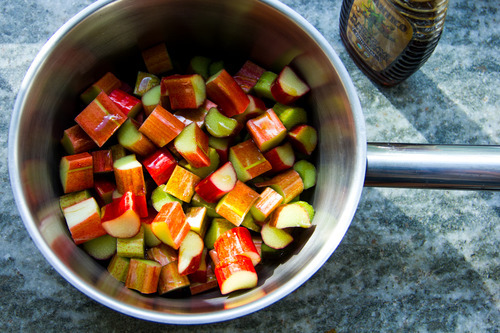
Rhubarb again! I love that slightly sour taste of rhubarb – and I love to pick produce and bake and cook according to the season. After a hard workout, the most important thing is to get a lot of protein, carbohydrates, and antioxidants. Protein bars are a great way to get everything you need, neatly packed into a to-go package. Rhubarb is rich in vitamin C, as well as the minerals calcium and potassium – and cooked rhubarb has high levels of the antioxidant polyphenol.
The protein in these bars comes from rice protein, which contains 65g of protein, 21g carbohydrates, and 4g of fat per 100g. They are sweetened with agave syrup and flavored with vanilla, rose hip, and goji berries.
12 bars
600g rhubarb, sliced
5 tbsp agave syrup
4 tbsp coconut oil
120g (about 2dl) rice protein
4dl rolled oats
2 tbsp rose hip powder
1 tsp vanilla powder
3 tbsp goji berries

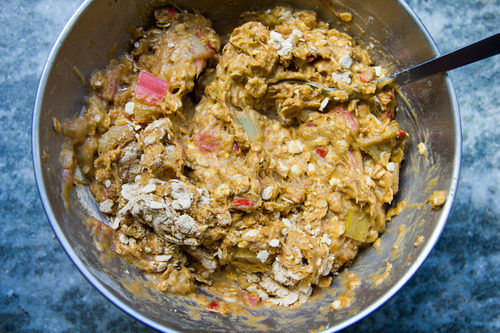
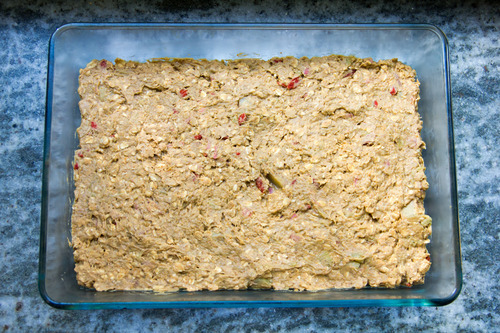
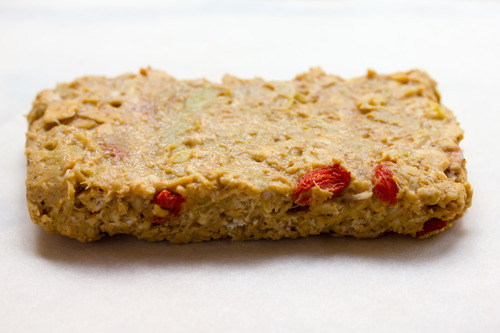


Saturday morning I woke up early with Milo, our one-year-old, and went to the kitchen. We sat by the kitchen table for a while blowing soap bubbles. He loves that and naturally he was curious to try by himself. Max went up and joined us for porridge breakfast and then he went out for a walk with Milo so that I could rest for a bit, and make this rhubarb dessert/snack that I had in mind.
I love rhubarb crumble pie, but I wanted to make something a little bit different, beautifully layered in a glass. The first layer is a vegan vanilla sauce, store-bought. Sometimes a shortcut in the kitchen is nice… The second is a rhubarb compote flavoured with vanilla and lemon, and naturally sweetened with date syrup. The top layer is oat and quinoa granola.

Recipe for Rhubarb Compote with Oat and Quinoa Granola
serves: 4 people
Rhubarb compote
500 g rhubarb stalks, sliced
4 tbsp date syrup, honey or other syrup of your choice
juice from one lemon
1 tsp vanilla extract or vanilla bean
Granola
400 ml rolled oats
100 ml quinoa seeds
2 tbsp date syrup, honey or other syrup of your choice
2 tbsp olive oil
2 tbsp water
a pinch of sea salt
a pinch of cinnamon
250 ml plant-based vanilla sauce


This is the time of year when parks and yards are beginning to overflow with hungry barbequers. This year, skip the steak and the tired old burgers and try throwing vegetables and vegetarian hot dogs on the barbeque instead! Add a tasty dip and you’ve got a great summer meal.
Like most of us, I love the sun, and I love to grab the cooler and the picnic blanket and treating the family to a picnic in the park close to where we live. The weather in Stockholm this past weekend was fantastic, so I bought a handy little pop-up barbeque that’s easy to bring along.

An easy thing to do is just to buy a bunch of different organic vegetables, putting them on a skewer and barbequing them just as they are. For protein, my new barbeque favorite is soy-based ”chicken”. If you’re in the US, try Beyond Meat’s Chicken-Free Strips (http://beyondmeat.com/products/). Some of these products are already seasoned, but a great tip is to marinate them in soy sauce, vinegar, and mint to give them an extra kick before grilling.
To accompany the skewers, I made a potato salad with the things I had at home, which happened to be beetroots and cucumber. I made the dressing with olive oil, mustard, agave syrup, and salt and pepper – perfect combination of light and creamy! Then I added the rest of the fresh mint to the salad. Add to that a nice side sauce with yoghurt, lime juice and mint – if you’re vegan, there are plenty of vegan yoghurt alternatives you can try. Other side dishes that are great with barbeque: red pesto with sundried tomato, olives and sunflower seeds, and avocado and feta cheese dip.

Roasted Bell Peppers and Walnut
Red pesto
Smokey Bean Spread
Olive Tofu
Avocado and Feta Cheese Dip: see recipe below
Guacamole
Pea and Cashew Pesto



Avocado and Feta Cheese Dip
6. Mash avocado in a bowl.
7. Crumble and add the feta cheese. Add salt and pepper. Mix until the dip is smooth.
Prepare this before the picnic, and keep the potato salad and avocado dip in a cooler.
Guacamole
8. Crush or chop the garlic and put it in a mid-sized bowl. Split the avocado, remove the stone, and scoop out the inside with a spoon.
9. Add oil and lemon juice. Mash the avocado with a fork, then add salt and black pepper to taste.
BBQ
10. Light up the barbecue.
11. Cut the mushrooms in half. Cut the bell peppers and zucchini into large chunks.
12. If you are using scallion, remove the stalk. Peel, if you are using pearl onions or yellow onion. If you are using yellow onion, cut into chunks.
Split the chili lengthwise and remove the seeds before slicing.
13. Put the vegetables on skewers – put the different vegetables on separate skewers, as they have different cooking times.
14. Place the skewers on the barbeque grille and cook until the vegetables are soft. Onions take quite a long time, bell peppers are somewhere in the middle, and mushrooms cook the quickest.
15. Serve the skewers with potato salad and avocado dip.

Works especially well with barbequed soy chicken, tzay, and seitan skewers. 4 servings 10 minutes
5 tbsp peanut butter
1 tbsp sesame oil
1 tbsp rice wine vinegar
2 tsp sambal oelek
2 tsp agave syrup
1 tsp soy sauce
2-3 tbsp water
Mix all the ingredients well. Add more water if necessary. Everyone will love this one!
It usually doesn’t take much to get me into the kitchen, but lately it’s been a bigger challenge than usual since our one-year-old Milo is running around my feet the minute I get home from work. Babies go through a number of mental development phases and when they are in the middle of a phase they tend to demand more of their parents. The funniest thing he knows right now is to play at the beach and digging in the sand. We had a nice time together Saturday morning at the beach at Liljeholmsbadet. In the evening we had a picnic with friends and had summer rolls with peanut sauce and grilled vegetable skewers, bananas with chocolate and marshmallows.
We’ve got ourselves a nice little popup bbq that we can easily bring to the parks nearby. We’ll give you more plant-based bbq inspiration in a later blog post. When the kids are demanding all your attention or you simply want to maximise the time out in the sun, we are grateful to all the good ready-to-eat vegan products you can buy these days. I made a top 10 list with my favourites in Stockholm, Sweden. Please email us (hello(at)filibaba.com) if you want to share a top list with plant-based products in your city!
1. Oatley iMat fraiche
Finally a replacement for cow milk-based creme fraiche/sour cream.
2. Astrid & Apornas Chi-Chi
Bit-size chicken replacement. I marinated the Chi-chi and Chinese soy sauce, vinegar and fresh mint. Then I grilled them on skewers. They turned out very delicious and with a texture that beets the original.
3. Astrid & Apornas Jeezly original
Fake cheese to put on the sandwich to remind you of sweet childhood memories.
4. Anamma’s veggie fillets
Fake pork or chicken cutlets out of soy protein etc. Great texture.
5. Astrid & Apornas Mayo Chipotle
Nice and spicy egg-free mayonnaise. Great on an avocado and tomato sandwich.
6. Seitan skewers
An old favourite made from wheat gluten instead of soy protein. If you like asian spices and creamy filling food, you’ll love our recipe for Seitan Skewers with Potato Coconut Milk Puree, Red Currant Jelly, Ruccola and Peanut Sauce.
7. Astrid & Aporna’s Hot Chörizo
Fake sausages are perfect for a quick dinner now and then. Fry the sausages and serve with bread, ketchup and mustard along with pickled vegetables or cabbage of some sort. If I don’t have the latter I just fry up some shredded white cabbage and season with vinegar and sea salt.
8. Alpro unsweetened almond milk
A staple in my pantry. I eat it with muesli, on the porridge, in chocolate drinks, smoothies etc.
Recipe for naturally sweetened chocolate drink:
2 tsp raw cacao powder
2 tsp date syrup
200 ml/1 scant cup almond milk
First mix 2 tsp cacao powder, 2 tsp date syrup and a tiny splash of almond milk, into a smooth mix in a cup. If you use too little or too much almond milk, it’ll be impossible to get it properly combined. Training is needed. Fortunately there are worse things to practice… Drink the chocolate hot or cold. It goes very well with the cheese sandwich in 3.
9. Oatley iMat cream
An old favourite in cooking. Neutral taste = goes with everything.
10. Oatley oat milk
Some prefer almond milk and some oat or soy milk. I like variation. It can be so good with a glass of ice cold oat milk a warm summer day. You must also try our naturally sweetened frappucino smoothie with oat milk, bananas and cardamom.
/Jenny

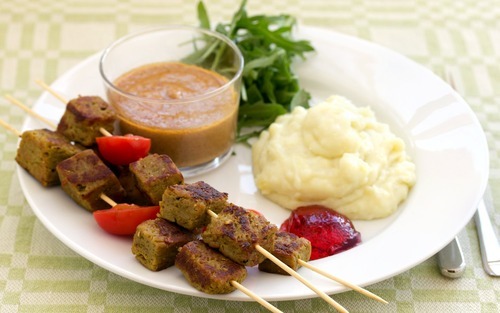

Ginger has been used for thousands of years and is today one of our most appreciated spices. Filibaba has collected a bunch of studies revealing that this knobby little plant has a lot of health benefits. We also provide our best recipes with fresh ginger.
Ginger (Zingiber officinale) is an ancient plant that originally grew wild in Southern China. It has long been used in traditional Chinese medicine to cure a number of ailments such as stomach problems and colds. About 2000 years ago, ginger was first exported from Asia to the Roman Empire. The Romans spiced their wine with the popular plant in order to settle the stomach. Ginger was one of the very first oriental spices to reach Europe, right after cinnamon and pepper.
Ginger belongs to the ginger family, and the plant grows to about a meter in height, with long, sword-shaped leaves and clusters of yellow flowers. Nowadays, it is rare to see ginger growing wild. Instead, it is cultivated in various tropical regions, such as India, China, Jamaica, and Indonesia. This root needs plenty of moisture, rain and warmth, in order to thrive. The active constituent in the plant is known as gingerol, which is known to alleviate digestive problems, among other ailments. Ginger is also rich in antioxidants.
Ginger is used around the world to alleviate nausea. A study at the University of Rochester Medical Center in the U.S. (2009) showed that cancer patients undergoing chemotherapy who received ginger had reduced levels of nausea by up to 40 percent compared to placebo. The best results were found among those receiving between 0.5 and 1.0 grams of ginger, twice a day. Researchers at China Medical University in Taiwan (2007) discovered that ginger also prevents diarrhea. Their results showed that the antioxidants in the root prevent the poison that the bacteria secrete from taking hold in the gut.
Ginger has a mucolytic effect and helps to cleanse the body of infections, so it’s great to eat when you have a cold. It has also been shown to have a positive effect on asthmatics, as ginger facilitates respiration (Columbia University 2013). Ginger is also anti-inflammatory and alleviates pain and swelling. Research from University of Georgia (2009) shows that a daily intake of ginger alleviates muscle soreness. In a study, participants were given either raw ginger, heated ginger, or a placebo for eleven days. Earlier studies had indicated that heated ginger might have a better effect on alleviating pain, but the University of Georgia research team came to the conclusion that raw ginger worked just as well. A daily intake of ginger reduced muscle pain with up to 25 percent.
With pepper and chili, ginger is one of the world’s most popular spices. It can be used fresh, pickled, and dried. The root contains essential oils with a very characteristic flavor – it’s fruity and bitingly hot at the same time. Ginger is an important ingredient in Asian cooking. In Japan, ginger is marinated with sashimi and sushi. In the west, ground, dried ginger is often used to flavor pies and desserts, but it’s also excellent for pickling. And of course, it’s the primary flavor in ginger ale and ginger beer. Kept in a paper bag in the fridge, fresh ginger can keep for several weeks. You can also keep it in the freezer.
Here’s a selection of our best recipes with ginger, with everything from family dinners such as sushi and dumplings, to smoothies and treats. You have to try the Kiwi Soup with cloudy apple juice and almond biscuits, it is really good. We always serve the Ginger and Cinnamon Cocktail at parties, it’s simply divine. PS. Make large pitchers of it, everyone will ask for more.
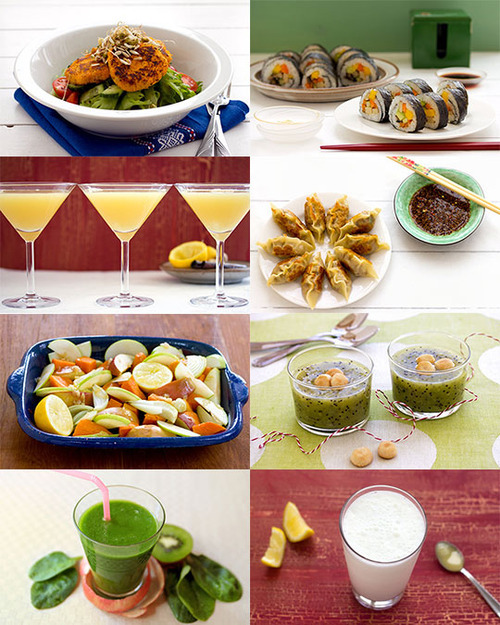
Original text: Emelie Kalén
Translation: Olivia Olsen
Recipes and photos: Jenny Sundén
Shidrokh Ghawami is the founder of the popular beauty salon Orkidés in Stockholm. She has also studied nutrition, and three years ago she made a complete diet overhaul, based on what she felt worked best for her and her body. Her diet is organic, without any unnecessary additives, and she only eats meat once a month. Today, she’s got more energy than ever!
Shidrokh has always had a passionate interest in chemistry and ingredients. For a while, she studied biochemistry, but after three semesters it was clear to her that she did not want to become a chemist. She chose another field and in 1996 became an esthetician. After she had finished her studies, she taught chemistry at various cosmetology programs. But in the mean time, a dream developed – to open her own salon.
– I wanted to offer quality skin care that everyone can afford, says Shidrokh. It was also important to me to spend as much time as necessary with every client. When clients come in for treatment, they should also leave with good information and understanding of their skin.
In 2000, Shidrokh opened the doors to her very own salon. At the time, she was renting a room on the outskirts of the city, in order to keep costs at a minimum. Now, with 20 years in the business, she has many loyal customers and a location in the middle of the city.
– Now, even my clients’ children are starting to come, it’s a lot of fun, she says. Working with skin care at her salon is her calling, she explains – there was never any alternative.
– The most rewarding part of my work is when clients see results they never would have expected. Their eyes light up in surprise.
The skin is the largest organ in the body – and also the most exposed. Shidrokh explains that the key to healthy skin lies in much more than just a miracle cream. It’s all about maintaining a sustainable lifestyle and finding ingredients that are appropriate for the skin in the condition it’s in. The food we eat has a huge influence on the skin.
Besides her work at the salon, Shidrokh offers courses in nutrition. And three years ago, she felt it was time for a change. So she changed the way she ate.
– My eating habits weren’t particularly bad, but I still felt that I needed to take a closer look and really investigate what my body needed, she says.
Over the course of a year, Shidrokh tried different foods, always taking note of how she felt after the meal. Did she feel energized, or did she end up in a food coma?
– We’re all different, so it’s important to figure out what your own body needs. Broccoli, which is healthy and said to be good for everyone, makes me feel terrible
– I just can’t digest it. Pasta and dairy with lactose are also bad for me, she says.
In her role as nutritionist she often speaks of the importance of taking control of your eating habits once and for all, and adapting your diet to your body. If certain foods don’t make you feel well, those are not the foods for you.
– It doesn’t have to be complicated. Buy fresh ingredients without additives. Slices of tomato on a piece of crisp bread and an omelet: it can be that simple.
Today, Shidrokh eats almost exclusively organic food. And she only eats meat once a month – a week before menstruation. She buys organic minced meat from a farm on Gotland that she knows well.
– I eat it for the amino acids, which are good for me when I’m on my period. Otherwise, I feel better without meat in my diet, because my digestive system can’t quite break down the proteins, she says.
With the new diet, she’s seen a number of positive changes: she sleeps better, she has lost weight, and the pain in her knees has disappeared.
– I’ve lost 20 kilos, and I have much more energy. I no longer feel tired in the afternoon, and I can run again. It’s such a wonderful feeling, I feel as though I could fly, she says.
Text: Emelie Kalén
Translation: Olivia Olsen
I’m often asked for tips for good, healthy snacks. It’s especially important for those who exercise regularly to load up on energy before exercise, and with carbohydrates and protein afterwards. Even if exercise is not on the agenda, a light snack is a great way to get some extra energy and keep blood sugar levels steady between meals.
1. A slice of rye bread with peanut butter and sliced banana
Who knew that this combo contains 7 g of protein? Peanut butter used to be associated with white toast and jellies full of sugar, but it’s making a comeback – and rightly so. There are plenty of organic options that are made almost entirely of peanuts (over 99%). The somewhat rough consistency is offset by the sweet, smooth bananas.
2. Beetroot and raspberry smoothie with ginger
Boil beetroots until they are soft ahead of time, and keep in the fridge. For one glass, I use a fairly small, boiled beetroot and mix it with 200 ml (a scant cup) frozen raspberries, 1 banana, 1 tbsp grated ginger, 100 ml (a half scant cup) almond milk, 100 ml (a half scant cup) water, ½ tbsp. lemon juice, and, if I have them, ½ tbsp. pomegranate seeds or goji berries. This is a super healthy snack that’s just filling enough – and done in a matter of minutes. I almost fell off my chair when I calculated its nutritional value at Edamam. It contains 8 g of protein!

3. Home-baked protein bars with nuts, seeds, and dried fruit
The time it takes to bake your own protein bars is far outweighed by the fact that you know have a snack that’s easy to eat on the go – and you know exactly what’s in it! You’ll find the recipe here.
4. Cottage cheese with nuts, dried fruit and goji berries
Cottage cheese is low-fat and rich in protein (100 ml/1 scant cup equals 10 g protein), so it’s a old favorite. Nuts provide healthy fats, and dried fruit contribute with energy and vitamins. Ladle some cottage cheese into a wide glass and sprinkle nuts, fruits, and berries on top. Add a bit of agave, if you want.
5. Avocado with herb salt, lemon, and chia seeds
Super easy and delicious if you ask me. This snack is better pre-exercising, as it’s not very rich in protein (about 4 g). Cut the avocado in half and remove the stone. Sprinkle salt, lemon, and chia seeds over. Eat as is with a teaspoon.
6. Sourdough bread with green pea pesto, tomato, and alfalfa sprouts (13-14 g protein)
Green pea pesto is made, as the name suggests, with green peas (2dl), mixed in a food processor with 100 ml (a half scant cup) cashew nuts, 100 ml (a half scant cup) rapeseed oil, 10 fresh oregano leaves, ½ tsp green peppercorns and ½ tsp salt. Recipe here. The result is a light, mild spread that can be eaten with almost anything. Spread a generous amount on a slice of bread and top with a few slices of tomato and some alfalfa sprouts. Yum!

7. Almond milk or Turkish yoghurt with müsli, raspberries, and rosehip powder
Pour almond milk into a bowl and top up with müsli, raspberries (I usually use frozen raspberries) and rosehip poweder. Rosehip powder is incredibly rich in vitamin C and is said to have a bunch of other benefits that prevent disease.

I also wanted to post a recipe for muffins here today, but I’m still not completely satisfied with the recipe. Take a look in the kitchen on Instagram, and follow us on Facebook or Twitter, and we’ll let you know as soon as the recipe is ready!
Text and photos: Jenny Sundén
Exotic superfoods, such as maca, goji, açaí, and lúcuma are bought by the bucketful by health-conscious consumers in the West. They’ve been transported across half the earth and cost a fortune – but there are much cheaper and more environmentally friendly options available. Why not make the most of what our own local, Nordic nature has to offer?
Berries are not only beautiful and delicious, they also contain a number of antioxidants, which help take care of excess free radicals that cause damage to the body.
“Superberries” is the word we use to describe berries that have a particularly high concentration of nutrients. Filibaba has taken a closer look at a few of them.
According to the Swedish National Food Agency, blueberries are the second most consumed type of berries in Sweden. They grow wild all over the country. Anthocyanin doesn’t only give the blueberries their blue color – it is also a powerful antioxidant that helps strengthen the immune system, lowers cholesterol and reduces the risk of cancer.
The berries also contain fibers, as well as vitamins C, K, and, B6. Eating blueberries will also get you a good dose of beta-carotene, which has antibacterial and anti-inflammatory properties and is a source of provitamin A. Blueberries are ripe to be harvested in July and August.
This thorny health bomb is not only great if you suffer from joint pain – with its high vitamin content (270 milligrams of vitamin C per 100 grams) this berry will also strengthen your immune system.
A study made at Lund University (2012) has shown that rosehips can lower both blood sugar levels and cholesterol. Rosehips are part of the rose family, and grow mostly along the coasts in the southern parts of the country. When the berries shine bright red like tiny Christmas baubles, their flavor is at its strongest. They are usually ready to be harvested in September. Rosehips also contain minerals such as iron, calcium, and potassium.
Sea buckthorn grows wild, most commonly along the Baltic coast, but also on the west coast. The range and availability of buckthorn products on the Swedish market has increased a great deal in the last few years thanks to the high levels of antioxidants in the berries. According to a study by the National Food Agency (2011), a single serving of sea buckthorn contains more than the recommended daily dose of vitamins C for adults (131 milligrams per 100 grams). The study also showed high levels of vitamin K and carotenoids, which are organic pigments and nutrients.
Norrbotten, the northernmost county in Sweden, stands for about 40 percent of the blackcurrant harvest in the country. An analysis by the National Food Agency (2011) shows that blackcurrants contain much higher levels of vitamin C than many other Swedish berries. 100 grams of blackcurrants gives 150 milligrams of vitamin C. These juicy berries also contain anthocyanin. Blackcurrants can be made into juice, jelly, or preserves, and the leaves can be boiled to make tea. Blackcurrants also lower blood sugar levels and are good for the stomach. Blackcurrant juice was traditionally used to alleviate cold symptoms.
Text: Emelie Kalén | Photos: Jenny Sundén | Translation: Olivia Olsen